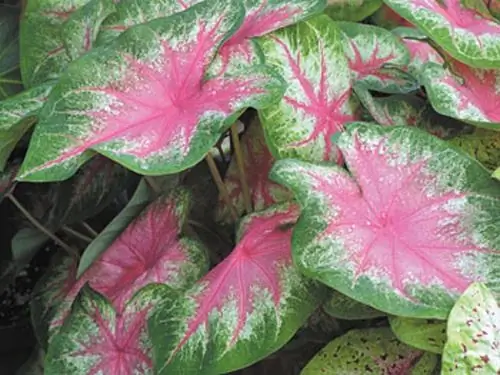Caladium is a very bright beautiful large plant with large multi-colored leaves. They are decorated with unique patterns of various spots, veins, fringes, fancy transitions from one color to another. In its patterns, you can see combinations of silver, white, pink, crimson, red, all shades of green. But despite this, amateur flower growers undeservedly pass by. All due to the fact that this plant has a long dormant period. From the beginning of autumn to the end of February, the foliage of this plant dies off, and the tuber hibernates.

Instructions
Step 1
Conditions of detention.
Like all tropical plants, Caladium loves a warm, humid content, does not tolerate drafts and direct sun. Best of all, this flower feels on the east and west windows in bright but diffused light. Lack of light immediately affects the color of the leaves. The best temperature for keeping it is 20-25 degrees, even when the caladium is at rest - it should not drop below 20 degrees. Temperature drops, drafts are destructive for this plant. It also requires high humidity and regular cleaning of leaves from dust.

Step 2
Watering.
Caladium is a marsh plant, so it loves uniform watering. The soil must be permeable, loose, because it is a tuberous plant, and when the soil becomes acidic, it dies. From the beginning of autumn, watering should be gradually reduced, then stopped altogether. When the leaves die off, the tubers are dug up, removed from the roots and stored. Can be stored directly in pots. On awakening, flower growers often make a mistake that leads to rotting of the tuber. As long as there are no large leaves, the plant should be watered very sparingly. It has not yet formed full-fledged roots that can absorb large amounts of water. Caladium is fed during the growth period 2-3 times a month.

Step 3
Transfer.
At the end of winter, as soon as a new bud appears, the tuber is transplanted into a new pot. Good drainage is essential. The soil should be light and loose, consist of leafy soil, tof and perlite, in a ratio of 2: 1: 0, 5. If the tuber is planted deeply, then the plant will have large leaves and subsequently form a large tuber. And if, on the contrary, it is small, then there will be more additional shoots, but the leaves will be smaller.
Step 4
Reproduction.
The flower is propagated by small daughter nodules. You can divide the old tuber into parts, but there is a risk of decay. The tuber is divided into parts, rolled in coal, dried and planted. You can remove the first bud of growth from the awakened caladium, in two weeks new ones will appear, with which it is planted in the soil. As a result, in the fall, the tuber itself is divided into several new parts.
Step 5
Diseases.
Pests usually bypass it. But quite often there are a variety of rot. Regular inspection will help prevent plant death. The decayed tuber is cut to healthy tissues, soaked in a solution of Metronidazole. Sprinkle with coal, and sphagnum is planted in moss until roots form, then only sprinkle with earth.






